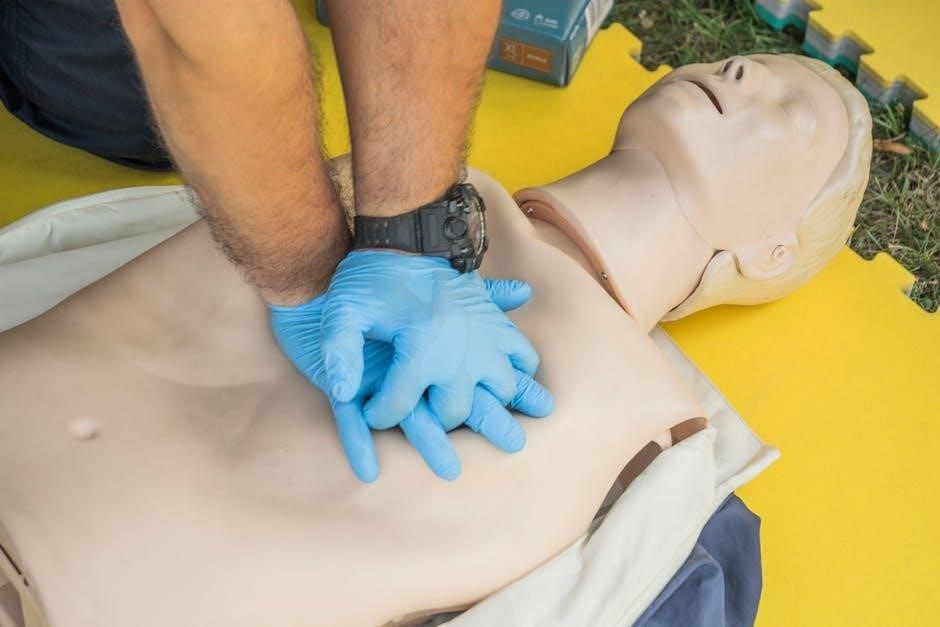Resuscitation Manual: A Comprehensive Guide

This comprehensive guide provides updated protocols and insights into resuscitation. It emphasizes the critical importance of effective techniques and ethical considerations. Focusing on community integrated responses and emerging technologies in emergency medicine.
Resuscitation encompasses a series of life-saving interventions aimed at restoring vital functions, such as breathing and circulation, in individuals experiencing cardiac arrest, respiratory failure, or other life-threatening conditions. This manual serves as a comprehensive resource, integrating the latest guidelines and best practices in resuscitation techniques.
The core principle lies in recognizing the importance of early intervention. Prompt initiation of basic life support (BLS), including chest compressions and rescue breaths, can significantly improve survival rates. Furthermore, the integration of automated external defibrillators (AEDs) in community settings has proven crucial in addressing out-of-hospital cardiac arrests.
Understanding the ethical and legal frameworks surrounding resuscitation, including do-not-attempt-cardiopulmonary-resuscitation (DNACPR) orders, is essential for healthcare providers. Effective communication, teamwork, and a coordinated community response are vital components for successful resuscitation outcomes. This manual aims to equip healthcare professionals with the necessary knowledge and skills to deliver optimal care during critical situations.
Basic Life Support (BLS)
Basic Life Support (BLS) forms the cornerstone of resuscitation efforts, emphasizing immediate interventions to maintain oxygenation and circulation until advanced medical care arrives. Key components include recognizing cardiac arrest, activating the emergency response system, and initiating high-quality chest compressions.
Effective chest compressions are crucial, requiring adequate rate and depth to circulate blood to vital organs. Rescue breaths, delivered in conjunction with chest compressions, provide oxygen to the lungs. BLS also involves managing airway obstruction using techniques like the Heimlich maneuver.
The integration of automated external defibrillators (AEDs) into BLS protocols has significantly improved outcomes in out-of-hospital cardiac arrests. AEDs deliver controlled electrical shocks to restore a normal heart rhythm. BLS training programs emphasize hands-on practice and skill proficiency. Regular refresher courses are essential to maintain competency and ensure effective response during critical situations. Mastering BLS techniques empowers individuals to act swiftly and confidently, potentially saving lives during emergencies.
Advanced Life Support (ALS)
Advanced Life Support (ALS) builds upon the foundation of BLS, incorporating advanced techniques, pharmacological interventions, and monitoring to manage complex cardiac emergencies. ALS involves advanced airway management, including endotracheal intubation and the use of supraglottic airways, to ensure adequate oxygenation and ventilation.
Cardiac monitoring and rhythm interpretation are essential components of ALS, allowing healthcare providers to identify and treat life-threatening arrhythmias. Pharmacological interventions, such as the administration of epinephrine and antiarrhythmics, play a crucial role in restoring cardiac stability. ALS also addresses reversible causes of cardiac arrest, including hypovolemia, hypoxia, and electrolyte imbalances.
Effective teamwork and communication are paramount during ALS resuscitation efforts. A coordinated approach, involving physicians, nurses, and paramedics, ensures efficient and effective delivery of care. ALS algorithms provide a structured framework for managing cardiac arrest, guiding healthcare providers through a systematic approach to assessment and treatment. Continuous training and education are essential to maintain proficiency in ALS techniques and optimize patient outcomes in critical situations. ALS represents a comprehensive approach to managing life-threatening cardiac emergencies.

Specific Scenarios and Considerations
Resuscitation protocols vary depending on the specific patient population and setting. Factors such as age, underlying medical conditions, and location influence the resuscitation strategy and require tailored approaches for optimal outcomes.
Resuscitation at Birth and Transition Support
Resuscitation at birth requires specialized knowledge and skills. It focuses on supporting the newborn’s transition to independent breathing. This section emphasizes the importance of early identification of infants who require assistance. The guidelines have shifted to prioritize supporting transition, rather than solely focusing on resuscitation. Effective communication is crucial during this time, especially when supporting the father.
The initial steps involve providing warmth, clearing the airway, and stimulating breathing. If these measures are insufficient, positive pressure ventilation should be initiated. Continuous monitoring of heart rate and oxygen saturation is essential to guide further interventions. Advanced techniques, such as chest compressions and medication administration, may be necessary in certain cases. A structured approach, based on established algorithms, enhances the effectiveness of newborn resuscitation. It is very important to know the guidelines.
These guidelines aim to improve outcomes for newborns requiring resuscitation and support during the critical transition period. This includes providing support for the family.
Resuscitation in Hospice and Palliative Care Settings
Resuscitation in hospice and palliative care settings presents unique ethical and clinical challenges. The primary focus is on comfort and quality of life, rather than prolonging life at all costs. Decisions regarding resuscitation must align with the patient’s wishes and goals of care, as documented in advance directives or through discussions with the patient and their family. It’s essential that the rotational doctors know skills.
Given the lack of hospice-specific resuscitation guidelines, existing protocols are adapted to suit the specific needs of these patients. A thorough assessment of the patient’s condition and prognosis is crucial to determine the appropriateness of resuscitation efforts. Do-Not-Attempt-Resuscitation (DNAR) orders should be clearly documented and readily available to all healthcare providers. Effective communication with the patient and family is paramount to ensure their understanding and involvement in the decision-making process.
The goal is to provide compassionate and respectful care that honors the patient’s values and preferences. Resuscitation efforts should only be undertaken if they are consistent with the overall goals of care and have a reasonable chance of improving the patient’s quality of life.
Out-of-Hospital Cardiac Arrest (OHCA)
Out-of-Hospital Cardiac Arrest (OHCA) presents a significant challenge, demanding rapid and coordinated intervention to improve survival rates. The critical first steps involve immediate recognition of cardiac arrest and activation of emergency medical services (EMS). Bystander cardiopulmonary resuscitation (CPR) plays a vital role in maintaining circulation until professional help arrives. Early defibrillation, ideally with automated external defibrillators (AEDs), can dramatically increase the chances of successful resuscitation. A simple prediction rule might help EMTs make a difficult decision.
EMS personnel must quickly assess the patient, initiate advanced life support measures, and transport the patient to a hospital equipped to provide comprehensive cardiac care. Post-cardiac arrest care focuses on optimizing hemodynamic stability, managing neurological injury, and addressing underlying causes of the arrest. Data collection through initiatives like the Pan Asian Resuscitation Outcomes Study (PAROS) is crucial for monitoring outcomes and identifying areas for improvement in OHCA management. The emphasis is always on integrated community response.
Effective strategies for improving OHCA outcomes include public education programs on CPR and AED use, widespread AED availability in public places, and streamlined communication between dispatchers, first responders, and hospitals.
The Role of Automated External Defibrillators (AEDs)
Automated External Defibrillators (AEDs) are pivotal in improving survival rates following sudden cardiac arrest, particularly in out-of-hospital settings. These portable devices are designed for use by laypersons and first responders, providing clear, step-by-step instructions to guide users through the defibrillation process. The ease of use and availability of AEDs significantly reduces the time to defibrillation, a critical factor in determining survival. AEDs analyze the heart rhythm and deliver an electrical shock only if a shockable rhythm, such as ventricular fibrillation or ventricular tachycardia, is detected.
Public access defibrillation programs, which strategically place AEDs in public locations like schools, airports, and shopping malls, have proven highly effective in increasing the chances of successful resuscitation. These programs typically include training for community members on how to recognize cardiac arrest, perform CPR, and use an AED. Regular maintenance and inspection of AEDs are essential to ensure they are in proper working order when needed. The new 2015 guidelines emphasize the importance of an integrated community response, highlighting the role of AEDs in a comprehensive approach to cardiac arrest management.
Effective communication during resuscitation, including clear instructions from the AED, is crucial for maximizing the device’s impact.

Ethical and Legal Considerations
Ethical and legal standards are paramount in resuscitation, guiding appropriate interventions and respecting patient autonomy. Guidelines outline the legal and ethical standards for resuscitation, including respecting DNACPR orders. Communication is also key during this difficult process.

Do Not Attempt Cardiopulmonary Resuscitation (DNACPR) Orders
Do Not Attempt Cardiopulmonary Resuscitation (DNACPR) orders are crucial documents that express a patient’s informed decision regarding resuscitation efforts. These orders, when valid, must be respected by healthcare providers. Scoping reviews explore the evidence regarding DNACPR processes, focusing on communication and adherence to patient decisions and recommendations.
The British Medical Association (BMA), Resuscitation Council (UK), and Royal College of Nursing (RCN) have published guidelines outlining the legal and ethical standards for DNACPR orders. These guidelines emphasize the importance of clear communication with patients and their families regarding the implications of such orders.
Adherence to DNACPR orders requires a thorough understanding of the patient’s wishes, documented evidence of informed consent, and effective communication among the healthcare team. Proper documentation and regular review of these orders are essential to ensure that patient autonomy is respected and that the medical team acts in accordance with the patient’s expressed preferences.
Legal and Ethical Standards in Resuscitation

Resuscitation efforts are governed by a complex interplay of legal and ethical standards, ensuring patient rights and provider responsibilities are upheld. These standards dictate when and how resuscitation should be initiated, taking into account patient autonomy, beneficence, non-maleficence, and justice. Guidelines published by organizations such as the British Medical Association (BMA), the Resuscitation Council (UK), and the Royal College of Nursing (RCN), provide frameworks for ethical decision-making.
One critical aspect involves respecting patient wishes, particularly through advance directives like Do Not Attempt Cardiopulmonary Resuscitation (DNACPR) orders. Valid DNACPR orders must be honored, reflecting the patient’s right to refuse medical intervention. However, legal and ethical dilemmas can arise when patient wishes are unclear, or when the patient lacks the capacity to make informed decisions.
In such cases, healthcare providers must engage in careful consideration, consulting with ethics committees and legal counsel as needed. Documentation of all decisions and discussions is paramount, ensuring transparency and accountability in the resuscitation process. Continuous education and training are vital for healthcare professionals to navigate these challenging situations effectively.

Teamwork and Communication
Effective teamwork and clear communication are crucial in resuscitation. This necessitates an integrated community response. Support for the father is also important. These factors improve outcomes and minimize errors during critical interventions.
Importance of an Integrated Community Response
An integrated community response is vital for improving resuscitation outcomes. Effective coordination between healthcare providers, first responders, and community members is essential. This approach ensures rapid and efficient intervention during cardiac emergencies.
Community involvement includes training laypersons in basic life support (BLS) and the use of automated external defibrillators (AEDs). Public awareness campaigns can educate individuals on recognizing the signs of cardiac arrest and initiating immediate action. Prompt bystander intervention significantly increases the chances of survival.
Furthermore, an integrated system facilitates seamless transitions between pre-hospital and in-hospital care. Clear communication protocols and standardized procedures ensure that vital information is relayed accurately and efficiently. This coordinated effort optimizes patient care and enhances the overall effectiveness of resuscitation efforts. Integrating community resources and promoting widespread training are key components of a successful resuscitation strategy.
Effective Communication During Resuscitation
Effective communication is paramount during resuscitation efforts. Clear, concise, and timely information exchange among team members is crucial for coordinated action and optimal patient outcomes. Standardized communication protocols, such as closed-loop communication, ensure that instructions are heard, understood, and acted upon.
Utilizing a designated team leader who directs and coordinates the resuscitation process enhances communication efficiency. This leader facilitates information flow, assigns tasks, and ensures that all team members are aware of the patient’s condition and the plan of action. Open and respectful dialogue fosters a collaborative environment, allowing for shared decision-making and problem-solving.
Furthermore, accurate documentation of interventions and patient responses is essential for continuity of care and post-event analysis. Effective communication extends beyond the immediate resuscitation team to include family members and other stakeholders. Providing timely updates and addressing concerns can help alleviate anxiety and foster trust. Ultimately, clear and compassionate communication is integral to successful resuscitation.

Emerging Trends and Technologies
Resuscitation is evolving with advancements in cardiac emergency medicine. Fibrinolytics during cardiac arrest and AEDs are improving outcomes. Exploring new technologies and integrated community responses will further enhance survival.
Advancements in Cardiac Emergency Medicine
Cardiac emergency medicine is rapidly advancing, transforming resuscitation protocols and improving patient outcomes. These advancements encompass novel pharmacological interventions, innovative devices, and refined techniques aimed at enhancing survival rates and minimizing long-term complications following cardiac arrest. The integration of cutting-edge technologies, such as improved automated external defibrillators (AEDs) and advanced monitoring systems, plays a crucial role in early detection and intervention.
Furthermore, research into the use of fibrinolytics during cardiac arrest resuscitation shows promise, offering a potential adjunct to conventional cardiopulmonary resuscitation (CPR) in specific patient populations. The development of more effective strategies for managing post-cardiac arrest syndrome, including targeted temperature management and advanced hemodynamic support, contributes to improved neurological outcomes and overall recovery. Emphasis on continuous education and training ensures healthcare professionals remain adept with the latest advancements, optimizing their ability to deliver timely and effective care during cardiac emergencies. These collective efforts are driving significant progress in the field, ultimately leading to better outcomes for patients experiencing cardiac arrest.

Fibrinolytics During Cardiac Arrest Resuscitation
The use of fibrinolytics during cardiac arrest resuscitation remains a topic of ongoing research and debate within the medical community. While the administration of fibrinolytics aims to dissolve blood clots that may be contributing to the cardiac arrest, its application requires careful consideration due to potential risks and benefits. Studies have explored the efficacy of fibrinolytics in specific scenarios, such as cardiac arrest secondary to pulmonary embolism or acute myocardial infarction, showing potential improvements in return of spontaneous circulation (ROSC) and survival rates.
However, the use of fibrinolytics also carries the risk of bleeding complications, necessitating a thorough assessment of the patient’s condition and contraindications. Current guidelines recommend considering fibrinolytics in select cases of cardiac arrest, particularly when a thrombotic etiology is suspected. Further research is needed to refine patient selection criteria and optimize the timing and dosage of fibrinolytics during resuscitation. Ongoing trials are investigating the role of point-of-care testing to rapidly identify patients who may benefit most from this intervention. The integration of fibrinolytics into resuscitation protocols requires a multidisciplinary approach, involving emergency medical services, cardiologists, and critical care specialists.

Future Directions
Future research aims to refine resuscitation techniques and improve patient outcomes. Data collection through studies like the Pan Asian Resuscitation Outcomes Study (PAROS) will guide advancements in cardiac emergency medicine and patient care.
Pan Asian Resuscitation Outcomes Study (PAROS)
The Pan Asian Resuscitation Outcomes Study (PAROS) is a crucial initiative for establishing standardized data collection methods related to out-of-hospital cardiac arrest (OHCA) across various Asian countries. This collaborative effort seeks to understand and improve resuscitation outcomes by analyzing comprehensive data on patient demographics, pre-hospital care, and in-hospital treatment.
PAROS facilitates the identification of regional variations in resuscitation practices and outcomes. By comparing data across different healthcare systems, researchers can pinpoint effective strategies and address areas needing improvement; The study’s findings contribute to evidence-based guidelines tailored to the unique challenges and resources available in the Pan-Asian region.
Furthermore, PAROS promotes collaboration among researchers, healthcare providers, and policymakers. This collaboration fosters a shared commitment to enhancing the quality of resuscitation care and ultimately improving survival rates after cardiac arrest. The insights gained from PAROS inform training programs, resource allocation, and the development of culturally sensitive resuscitation protocols.
